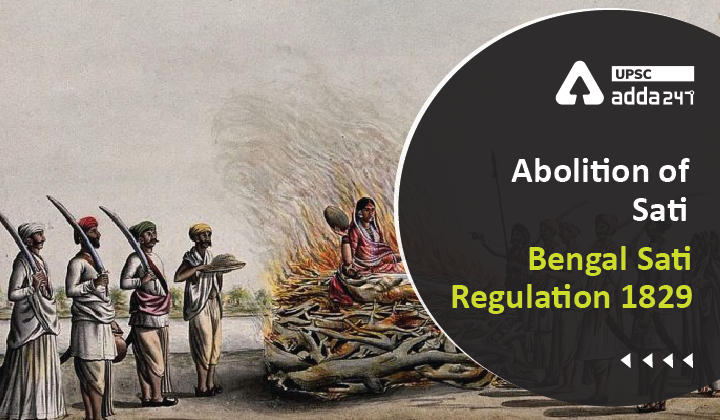Table of Contents
Abolition of Sati Relevance for UPSC Exam
Abolition of Sati was enforced by the British East India Company (EIC) by passing the Bengal Sati Regulation 1829. The practice of sati was made illegal by Bengal Sati Regulation 1829.
Abolition of Sati is also important for UPSC Prelims 2023 and UPSC Mains Exam (GS Paper 1- Various Socio-Religious Reforms in Modern Indian History).
Doctrine of Lapse | Modern Indian History
Abolition of Sati Context
- In 1829, the Governor-General of India Lord William Bentinck passed Bengal Sati Regulation 1829 which made the practice of Sati illegal in all of British India.
- Earlier, the Practice of Sati was banned by the Portuguese in Goa by 1515 and then by Dutch in Chinsura and French in Pondicherry.
What is Sati Practice?
- Sati was an inhumane practice against widowed women which traces its origin from late ancient and medieval era India.
- Sati had become prevalent in some parts of India, even though it lacked any support from ancient Vedic tradition.
- Sati was mainly practiced in upper Hindu Families which involved the immolation of a Hindu woman on the death of her husband in his funeral pyre.
- According to an estimate, in the year 1817 alone, about 700 widows were burnt alive.
Raja Ram Mohan Roy’s Efforts in Banning Sati Pratha
- Soul of Raja Ram Mohan Roy was tormented by the Sati Practice when his own sister-in-law was forced to commit Sati.
- Social reformer Raja Ram Mohan Roy along with his supporters started fierce opposition against Sati Practice in 1812.
- Raja Ram Mohan Roy took it on himself and used to visit cremation grounds and persuade women not to commit Sati.
- In his Sambad Kaumudi, He even showed that the Practice of Sati does not find mention in the Vedic literature.
Religious Conditions Under the Cholas
Banning of Sati Practice
- Due to the sustained efforts of Raja Ram Mohan Roy, Sati practice was formally banned in all the lands under Bengal Presidency by Lord William Bentinck on 4 December 1829.
- People who abetted the Practice of Sati were to be held guilty of committing ‘culpable Homicide’ offenses under the Bengal Sati Regulation Act 1829.
- Bengal Sati Regulation 1929, banning Sati, was applicable only to the Company’s jurisdiction in British India.
About Raja Ram Mohan Roy
- Birth: Raja Ram Mohan Roy was born in Radhanagar, Hooghly District of Bengal Presidency in May 1772.
- Raja Ram Mohan Roy was born into an orthodox Bengali Hindu family.
- Education:
- Raja Ram Mohan Roy attained higher education in Patna, Bihar where he studied Persian and Arabic.
- Learning various Languages: Raja Ram Mohan Roy had learned Bangla, Persian, Arabic and Sanskrit along with Hindi and English.
- Learning about Religions: Raja Ram Mohan Roy moved to Varanasi and studied the Vedas, the Upanishads and Hindu philosophy deeply.
- Raja Ram Mohan Roy also acquired knowledge about Christianity and Islam as well.
- Association with British Government: Raja Ram Mohan Roy worked in the Revenue Department of the East India Company from 1809 to 1814.
- Raja Ram Mohan Roy also worked as a personal Diwan to Woodforde and Digby.
- Association with Educational Institutions: Raja Ram Mohan Roy helped in establishing many educational institutions to educate Indians in Western scientific education in English. For example-
- Hindu College, (1817): Raja Ram Mohan Roy helped David Hare’s efforts to establish the Hindu College in 1817.
- Raja Ram Mohan Roy’s English school taught mechanics and Voltaire’s philosophy. In 1822, Raja Ram Mohan Roy founded a school based on English education.
- Vedanta college (1825): Vedanta College established by Raja Ram Mohan Roy, offered courses in both Indian learning and Western social and physical sciences.
Abolition of Sati FAQs
1. When was sati banned?
Ans. The practice of Sati was abolished by the Governor-General of India Lord William Bentinck by enacting the Bengal Sati Regulation 1829.
2. Which governor general banned the practice of Sati?
Ans. The practice of Sati was abolished by the Governor-General of India Lord William Bentinck with sustained efforts of Raja Ram Mohan Roy.
3. Who was first to ban the practice of sati in India?
Ans. The Practice of Sati was banned by the Portuguese in Goa by 1515 and then, by Dutch in Chinsura and French in Pondicherry.
4. Which regulation abolished the practice of Sati in India?
Ans. the Bengal Sati Regulation 1829 was introduced by the then governor general of India Lord William Bentinck which banned the practice of Sati in all of British India.
List of Socio-Religious Movements during 19th Century


 UPSC Prelims Exam Date 2024, Check New E...
UPSC Prelims Exam Date 2024, Check New E...
 UPSC Eligibility Criteria 2024- Age Limi...
UPSC Eligibility Criteria 2024- Age Limi...
 UKPSC RO ARO Result 2024 Out, Download M...
UKPSC RO ARO Result 2024 Out, Download M...







